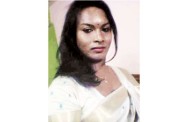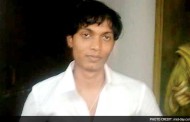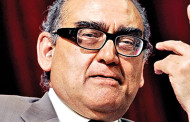More than a year and a half after the Supreme Court ruled that transgenders can be a third gender, a 32-year-old Odisha government officer has come out in the public with her transgender identity.
Ratikanta Pradhan, who got into Odisha Financial Service five years ago after clearing the Odisha Aadministrative Service examination, has now decided to become Aishwarya Rutuparna Pradhan. Posted as Commercial Tax Officer in Paradip Port township, Aishwarya said the April 15, 2014, Supreme Court ruling recognising transgenders under the third gender category and guaranteeing their constitutional rights was the key factor.
Hailing from a village in Kandhamal district, Pradhan initially faced disapproval from family and friends including her retired Armyman father. “But now everyone have started accepting me in a new avatar,” she said.
“In an affidavit before an executive magistrate, I have become Aishwarya Rutuparna Pradhan. I have submitted relevant records for change and modification of my name and gender. I expect to be conferred transgender classification on government records very shortly,” she said.
Mumbai: In a new twist to the double murder case of artist Hema Upadhyay and her lawyer Harish Bhambhani, the role of a sixth suspect is being probed even as fresh leads suggest that the prime accused Vidyadhar Rajbhar, who is on run, is preparing himself to surrender before police, a senior officer said here today.
Police have so far arrested Azad Rajhbhar, Pradeep Rajhbhar, Vijay Rajhbhar and Shivkumar Rajbhar alias ‘Sadhu’ in the case while Vidyadhar is absconding.
Meanwhile, Sadhu, formally placed under arrest today, was remanded in police custody till December 22 by a magistrate court here.
According to the officer attached to Crime Branch, the probable role of another person is coming to light in the crime. However, he refused to divulge details.
The officer said police had picked up Vidyadhar’s trail and are tracking him by putting his mobile phone under surveillance.
The officer said that Vidyadhar, a resident of suburban Kandivli, told his neighbour that he had killed Hema and Bhambhani over some financial dispute as the artist had owed him Rs 5 lakh and he was in debt.
Vidyadhar has a art workshop cum warehouse in Kandivli where Hema and Bhambhani were allegedly killed before their bodies were stuffed in cardboard boxes and dumped into a drain in Kandivli. The bodies were found on Saturday.
“Vidyadhar was last tracked at Itarsi railway station in Madhya Pradesh on December 13 and his mobile phone has been
switched off since then,” the officer said.
“He (Vidyadhar) boarded a train from Dadar station here on the very night (Saturday) when bodies were recovered.
Vidyadhar informed his neighbour (in Kandivli) that he had killed Hema and her lawyer and would surrender before police after returning to Mumbai,” he said, adding that Vidyadhar owed some money to the neighbour who has approached police.
Explaining the sequence of events, the officer said Vidyadhar had called Hema to his workshop in Laljipada on Saturday afternoon under the pretext of sharing some evidence, apparently in connection with the marital discord case against her estranged husband Chintan Upadhyay.
He said Vidyadhar had incurred a huge loss in his glass fabrication business and was deep in debt.
“Hema and Bhambhani visited Vidhyadhar at his shop cum warehouse on Saturday around 8:30 PM. There the trio had a heated argument following which Vidayadhar, with the help of other accused, killed the artist and the lawyer,” the officer said.
PTI
Nashik: Sharif Gafur Parkar, convicted and sentenced to life imprisonment in the 1993 Mumbai serial bomb blasts case, died at a hospital here following illness, jail authorities said on Friday.
Parkar (80), suffering from paralysis and a neurogenic disorder, died at the Nashik Civil Hospital yesterday, Nashik Road Central Jail Superintendent Ramesh Kamble told PTI.
Parkar had surrendered before a TADA court in Mumbai in May 2013 to serve the remaining part of his life sentence in connection with the case, after his conviction in the blasts case was upheld by the Supreme Court. Accordingly, he was lodged in the Nashik prison.
He was convicted by the TADA court for his role in organising the landing of arms and RDX in Raigad district prior to the March 1993 serial blasts, and in arranging a conspiracy meeting.
He was undergoing medical treatment for his illness in jail and Nashik Civil Hospital for past few months, Kamble said.
Parkar was also recently admitted in Mumbai’s JJ Hospital and two days back he was brought back to the prison here.
He was admitted to Nashik Civil Hospital two days back in the prisoners’ ward, where he died around noon yesterday. As per the procedure, the body has been sent for postmortem to Dhule civil hospital, Kamble said, adding that a case has been registered in connection with the death.
PTI
Beijing: Chinese lawmakers consider amending the family planning law to allow couples to have two children amid efforts to counter shrinkage of the work force and an ageing population. “The State advocates that one couple can give birth to two children,” Xinhua cited a draft amendment submitted for review at the bi-monthly session of the National People’s Congress Standing Committee which opened on Monday. The draft came after the Communist Party of China (CPC) Central Committee decided in October to give the go ahead for the universal two-child rule, which will replace the decades-long “one couple, one child” policy. Li Bin, head of National Health and Family Planning Commission (NHFPC), said the CPC’s decision was made to adapt to the transition of China’s population from young to old currently underway. In order to implement the decision, the top legislature must amend the family planning law which took effect in 2002. Under the current law, citizens who marry late and delay childbearing may be entitled to longer nuptial and maternity leaves. Couples who volunteer to have only one child in their lifetime enjoy rewards. The articles were deleted in the draft, implying the new law will likely take effect on January 1, 2016. The amendment will not affect the welfare enjoyed by the elderly whose family abides by the current family planning law, parents who have only one child and parents whose only child is disabled or deceased.
While clarifying the draft, Li said people who have been receiving rewards and assistance before the law was amended will continue to receive it afterwards. The draft also allows couples of a reproductive age to make their own choice whether to adopt contraceptive methods. It no longer stipulates that couples shall accept technical services and guidance for family planning. Medical institutes will also be able to employ assisted reproductive technology after being authorised based on their personnel, facilities and ethical management, according to the draft. Trade of sperm, ovum and embryo is forbidden. Surrogate pregnancy in any form is not allowed. Those involved in such actions would receive punishment ranging from warnings and fines to criminal penalties, according to the draft. China’s family planning policy was first introduced in the 1970s to rein in the surging population.
Since its implementation, the policy has resulted in an estimated reduction of some 400 million people in China, but it was also blamed for generating a number of social problems, mainly a decreasing labour force and an ageing population. In 2013, China relaxed its birth rules, allowing couples to qualify for a second birth if one of the partners was an only child. The one-child policy was abandoned at the Fifth Plenary Session of the 18th CPC Central Committee held in October this year. The change of policy is intended to balance population development and address the challenge of an ageing population, according to a communique issued after key meeting. Experts believe that being able to have two children will benefit about 100 million families around the country. The change in policy is expected to mean over 30 million more people in the labour force by 2050 and a decrease of two percentage points in the share of elderly of Chinese population, said Wang Peian, deputy head of the NHFPC, in a press conference held in November. The total population will slightly increase, with its peak reached at 1.45 billion in 2029, Wang said. The adopting of the two-child policy is also expected to boost China’s economic growth rate by about 0.5 percent, he said. IANS
Agartala, Dec 20 (IANS) A 60-year-old tribal woman in Tripura was beaten mercilessly and left unconscious by some people who accused her of having an illicit love affair, the police said on Sunday. The woman was rescued on Saturday morning and taken by her neighbours to a hospital where her condition was stated to be critical. The incident took place in Ujan Chandrapur village under Puratan Raj Bari police station of South Tripura district late Friday evening. “When the victim was returning home from NREGA (Mahatma Gandhi National Rural Employment Guarantee Act) work, she was first tied with a tree and then beaten ruthlessly by some locals, mostly women. Later her head was shaved,” said S.K. Paul, sub-divisional police officer of Belonia in South Tripura. Some of the local people accused the victim of having an illicit love affair with a man of her Bhil community. The woman’s family members denied the accusation. Six people, including four women, have been arrested in connection with the incident.
Former Supreme Court judge Markandey Katju calls IITians non-Indians while addressing the students of Indian Institute of Technology-Bombay.
He visited the Institution on Friday to speak on various issues. He said that the students of IIT do not have genuine love for the country and they are utterly selfish with no patriotism or idealism left among them.
Later he took to twitter where he posted “Most of you IIT students have no genuine love for the country. You are utterly selfish, with no patriotism or idealism.”
He even said that he doesn’t expect anything from IIT students.
“India should not have any hopes from you because eventually you will serve America or Germany,” he added.
In his Facebook post, Katju mentioned that IIT students are utterly selfish.
He wrote, “All you want is to migrate to America (and most of you manage to do that), usually by first going for an M.Tech degree there (for which you get a scholarship), and then settling down there and enjoying comfortable life — and to hell with India.”
Not only that, he even went on to the tax sector where he said, “Your education in IIT is largely subsidized by the Indian taxpayer. But after we Indians pay for your education, you are taken away by America who benefit form your knowledge, which was imparted by us.
He lashed at IITians and further mentioned, “And after settling down in America, you will become NRIs — supercilious know-alls, who will give lectures to Indians about what is good for them and what is not.”
Genre:Period Drama
Cast:Ranveer Singh, Deepika Padukone, Priyanka Chopra
Director:Sanjay Leela Bhansali
Maratha history gets the full-on Sanjay Leela Bhansali treatment in Bajirao Mastani.
The overwrought but impressive extravaganza elevates the legendary 18th century warrior-hero determined to establish Hindu rule across the subcontinent to the level of a selfless crusader for love in a climate of hate and bigotry.
Bhansali fictionalizes several of Bajirao’s key battles but focuses more on the married Peshwa’s passion for Mastani, the beautiful and courageous half Rajput, half-Muslim princess of Bundelkhand.
Every emotion in the film – be it love, longing or valour on the battlefield – is translated into a grand and elaborate song-and-dance routine.
A couple of the musical set pieces do not ring true in a historical epic about a man whose place in history is primarily as an unvanquished general.
These are but minor aberrations in a sweeping love story that is mounted on such a grandiose scale and crafted with such vaulting zeal that eventually the smaller details cease to matter.
Bajirao Mastani is, in many respects, Bhansali’s most subversive film to date. Its central message is that all religions preach love but love has no religion.
Love, the film conveys via Irrfan Khan’s voice, is a religion by itself and those that swear by its tenets become immortal like Bajirao and Mastani.
Peshwa Bajirao, played with flair by Ranveer Singh, takes on the unbending clergy and his own angry family to uphold Mastani’s dignity after she arrives in Pune as his second wife.
To liven up this “love story of a warrior”, Bhansali, as is his wont, rustles up a series of spectacular visuals, each as blindingly awash in red, russet and gold and bathed in light and shade as all the others.
Some of the pivotal scenes are well conceived and executed and their impact is enhanced by the impressive performances from the principal cast.
While it is difficult to take one’s eyes off the screen, the pace of the narrative, which runs for more than two and a half hours, is not consistent.
Large parts of the first half of Bajirao Mastani appear to serve only one purpose: setting the stage for a more explosive second half.
But the wait is well worth it: the pace of the film quickens considerably after the two women in Bajirao’s life come face to face.
The headstrong warrior’s wife Kashibai (Priyanka Chopra), mother Radhabai (Tanvi Azmi), brother Chimaji (Vaibhav Tatwawdi) and son Nana Saheb (Ayush Tandon), each in his own way, seek to prevent Mastani from worming her way into the Peshwa fold and the family’s abode – Shaniwarwadi.
Mastani (Deepika Padukone) is shunned, humiliated and even brutalized as she refuses to give up her claim on the man she loves.
She equates ishq (love) with ibaadat (worship), and notwithstanding the religious and social resistance from those around Bajirao she stands firm and bears him a son.
Mastani wants her son to be called Krishna but the custodians of faith force her and the boy’s father to settle for a less Hindu name, Shamsher Bahadur.
Right at the outset – obviously under mounting pressure from the descendants of Bajirao Peshwa and from some historical purists – the film offers what must surely go down in the annals of Bollywood as the longest-ever disclaimer.
Among other things, the director admits in the introductory rider that he has taken liberties with facts. He need not have bothered.
At no point does Bajirao Mastani look any different from all the fictional tales that Bhansali has spun in his eventful career.
Bajirao Mastani is watchable primarily because of the craft that is on view in the pretty frames lit meticulously by cinematographer Sudeep Chatterjee.
The characters allude repeatedly to the sky, to the sun and the moon, to the clouds and to the elements in general in the stodgy first half.
However, except in the competently mounted CGI-aided battles scenes, the sky is rarely seen.
The film instead shows the audience the Valhalla-like grandeur of the sets, the striking costumes designed by Anju Modi and faces lit by fire-torches.
The second half looks and feels markedly different because the visuals open out to take in the sky and the rain and the wind to convey the larger war that Bajirao must fight against his co-religionists.
Bhansali gives us a trio of remarkable women in Bajirao Mastani. Besides the admirable Mastani, a magnificent warrior-princess and a courageous lover, the film has Bajirao’s aggrieved but dignified wife Kashibai and his widowed mother.
Deepika is absolutely outstanding as Mastani, a woman in a man’s world, a Muslim in a conservative Chitpavan Brahmin setting, and a mother driven by the power of love.
Priyanka has less in terms of footage and hangs around in the backdrop for the most part. But when the drama gets into its stride, she too comes into her own.
Tanvi Azmi as Radhabai, a tonsured lady in white calling the shots and constantly testing the patience of her strong-willed first-born, delivers a power-packed performance.
Bajirao Mastani is Ranveer Singh’s film. It has scenes – especially the one in which the male protagonist’s presence and voice are pitted against the presence and voice of Raza Murad (in the guise of the Nizam of the Deccan) – in which he comes up a little short.
But there is no missing the enormous hard work that has been done in order to get into the skin of the character.
In one of the early scenes, Ranveer gets the Puneri accent to perfection, but, for an inexplicable reason, does not follow through with it.
Despite its failings, Bajirao Mastani is the work of a director who never shies away from going the whole hog.
Even when Bhansali isn’t in full flight, he still manages to soar well above the mundane.
Bajirao Mastani is for those that think history is boring. There isn’t a dull moment in this colourful and dramatic film that embraces excess with unabashed abandon.
MUMBAI: With nearly 10 people dying on the railway tracks in Mumbai every day and many among them falling off overcrowded local trains, the Bombay High Court on Wednesday came down heavily on the Railways.
The court asked the Railways to prevent unlimited boarding on trains to reduce overcrowding on a particular train during peak hour.
It also asked the Railways to ensure policemen are posted at sensitive stations to prevent entry in crowded trains. The Maharashtra government has also been asked to consider changing office timings to prevent overcrowding in suburban local trains at peak hour.
The court’s suggestions came while hearing a Public Interest Litigation or PIL on the issue. The court also asked the Railways to replace the bare steel rods at the entrance of bogies with rubber surfaced installations so that the hands of commuters do not slip and they do not fall off the trains while travelling on footboards.
A division bench of Justice Naresh Patil and Justice SB Shukre made the suggestions to the State and Railways to curb the spike in number of accidents taking place on local trains in the city, which are considered the financial capital’s lifeline.
The court went on to ask whether the cost of human life is more important or not while suggesting the change in working hours. Last year, 3,425 people died on the tracks. This year that figure has already crossed 3,000.
MUMBAI: Mumbai builder Kamal Yadav’s cellphone has saved his life, literally. On Tuesday night, the builder was shot at by a group of people. The cellphone in his trouser pocket stopped the bullet, and Mr Yadav sustained only a minor injury.
Mr Yadav, 45, the police said, had gone to a bar in Dombivli near Mumbai. On his way to the toilet, he ran into Jitendra Mhatre, another builder. Though Mr Yadav apologised, Mr Mhatre continued abusing him.
The matter did not end there. When Mr Yadav stepped out, after finishing his dinner, Mr Mhatre and his four friends followed. The police say they assaulted Mr Yadav, and Mr Mhatre pulled out his gun and fired four rounds.
While one round was fired in the air, two others whizzed past Mr Yadav’s cheeks, narrowly missing him. The fourth bullet, however, hit his mobile phone and grazed his thigh.
Mr Yadav was rushed to the hospital. Mr Mhatre has been booked for attempt to murder and the weapon has been seized.
MUMBAI: The family members of artist Hema Upadhyay, who was killed along with her lawyer last week, suspect the role of her estranged husband Chintan Upadhyay in the double murder and want the police to probe it.
The deceased artist’s cousin brother Deepak Prasad told mediapersons yesterday that he and his other family members “strongly suspect Mr Upadhyay’s role behind the conspiracy to kill Ms Hema and her 65-year-old lawyer Harish Bhambhani”.
Mr Prasad also said that the motive, as cited, of the prime accused Vidhyadhar Rajbhar and his men to kill Ms Hema and her lawyer for Rs. five lakh was not true, as she had financially helped Vidhyadhar in the past and never asked him to return her money.
He also alleged that some years back, Mr Upadhyay had threatened Ms Hema that he would kill her and could go to any extent to do that.
Meanwhile, a senior police officer, who is probing the case, said, “When a body is recovered and identified, police immediately take the statements of the deceased’s relatives to get their version.”
“In this case too, we had taken the statements of the deceased’s relatives. Ms Hema’s relatives have accused Mr Upadhyay of hatching the conspiracy to kill her,” he said.
Based on the statements of Ms Hema’s relatives, Mr Upadhyay was constantly grilled for four days by several police officers in connection with the twin murders, said the officer.
The deceased artist’s husband still remains a “suspect” in the case, he said, adding the motive behind the murder is yet to become clear.
However, without proper evidence, police cannot arrest anyone based on mere allegations, he further stated. Only after the arrest of the Vidhyadhar, who is on the run, the police could get a clear picture about involvement of Mr Upadhyay, if any, the officer said.
He also said that Ms Hema’s relatives were trying to build pressure on the investigating team by approaching the media and expressing their views which they have already mentioned in the statements given to police.
Bodies of noted installation artist Ms Hema,43, and her lawyer Harish Bhambhani wrapped in plastic and packed in separate cardboard boxes were found dumped in a drain in suburban Kandivali on December 12.
















Recent Comments